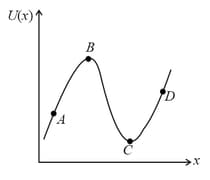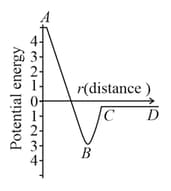EASY
Earn 100
A body of mass is suspended from massless spring of natural length . If mass is released from rest, spring can stretch up to a vertical distance of , the potential energy stored in the spring at this extension is ()
(a)
(b)
(c)
(d)
50% studentsanswered this correctly
Important Questions on Work, Energy and Power
EASY
EASY
EASY

EASY
EASY
MEDIUM
| Column-I | Column-II | ||
| (a) | (i) | ||
| (b) | (ii) | ||
| (c) | (iii) | ||
| (d) | (iv) | ||
EASY
EASY
MEDIUM
MEDIUM
MEDIUM
HARD
EASY
MEDIUM
EASY
EASY
The figure shows the variation of potential energy with distance. The part of the graph which represents the repulsive force is

HARD
MEDIUM
The graphs below show the magnitude of the force on a particle as it moves along the positive -axis from the origin to . The force is parallel to the -axis and conservative. The maximum magnitude has the same value for all graphs. Rank the situations according to the change in the potential energy associated with the force, least (or most negative) to greatest (or most positive).

MEDIUM
MEDIUM

